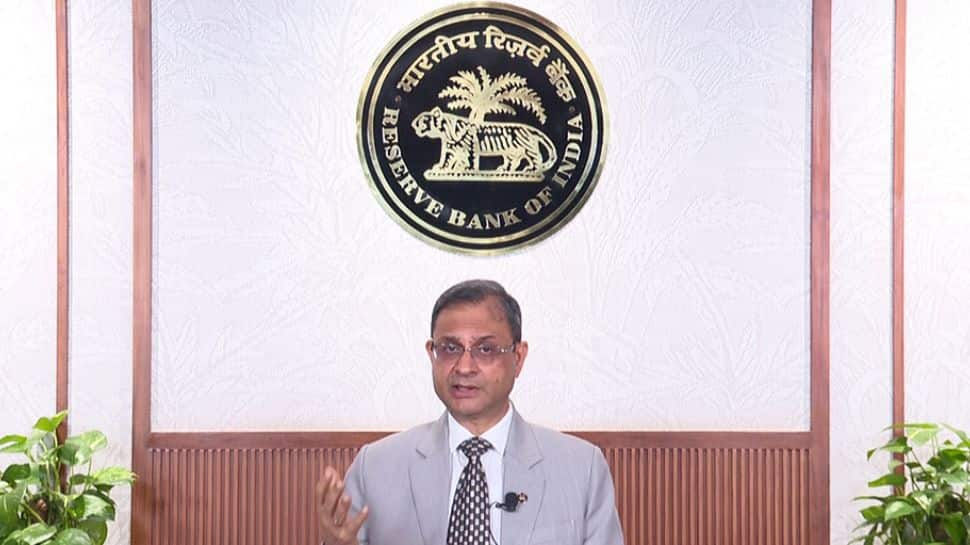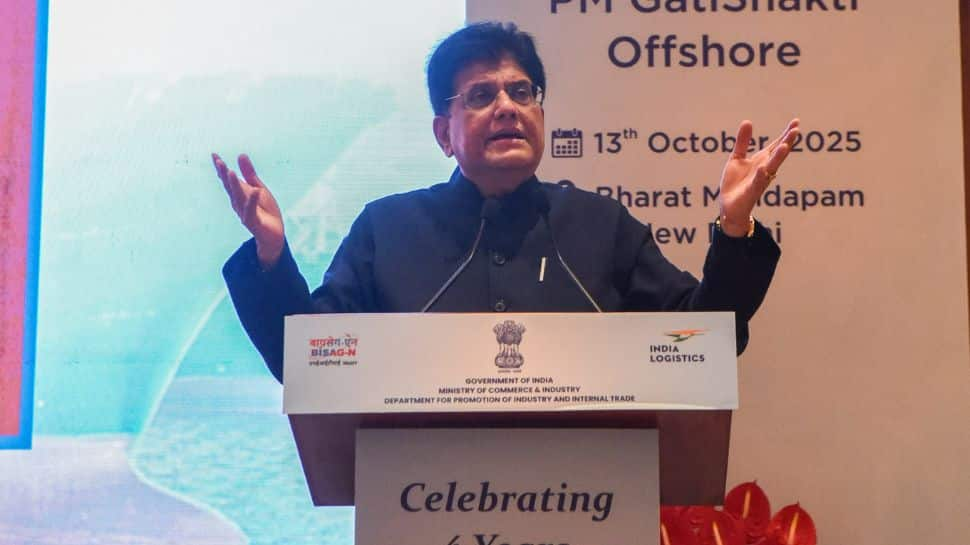Business
RBI Raises India’s GDP Growth Forecast To 6.8% For 2025-26

New Delhi: The RBI has raised its projection of India’s GDP growth rate to 6.8 per cent for 2025-26 from 6.5 per cent earlier, as the implementation of several growth-inducing structural reforms, including streamlining of GST, is expected to offset some of the adverse effects of the external headwinds, Reserve Bank Governor Sanjay Malhotra said on Wednesday.
He pointed out that India’s GDP recorded a robust growth of 7.8 per cent in Q1:2025-26, driven by strong private consumption and fixed investment. On the supply side, growth in gross value added (GVA) at 7.6 per cent was led by a revival in manufacturing and steady expansion in services. Available high-frequency indicators suggest that economic activity continues to remain resilient. Rural demand remains strong, riding on a good monsoon and robust agriculture activity, while urban demand is showing a gradual revival, the RBI Governor added.
“Taking all these factors into account, real GDP growth for 2025-26 is now projected at 6.8 per cent, with Q2 at 7.0 per cent, Q3 at 6.4 per cent, and Q4 at 6.2 per cent,” Malhotra explained. He also said that the global economy has been more resilient than anticipated in 2025, with robust growth in the US and China.
The outlook, however, remains clouded amidst elevated policy uncertainty. Inflation has remained above their respective targets in some advanced economies, posing fresh challenges for central banks as they navigate the shifting growth-inflation dynamics. Financial markets have been volatile. The US dollar strengthened after the upward revision of US growth numbers for the second quarter, and treasury yields hardened recently, tracking changes in policy rate expectations. Equities have remained buoyant across several advanced and emerging market economies.
The RBI Governor further stated that revenue expenditure of the Union and state governments registered robust growth during the fiscal year so far (April-July). Investment activity, as suggested by healthy growth in construction indicators, i.e., cement production and steel consumption in July-August, is holding up well even though production and import of capital goods witnessed some moderation. Recovery in the manufacturing sector continues while services activity is sustaining its momentum.
Looking ahead, an above normal monsoon, good progress of kharif sowing and adequate reservoir levels have further brightened prospects of agriculture and rural demand. Buoyancy in the services sector, coupled with steady employment conditions, is supportive of demand, which is expected to get a further boost from the rationalisation of goods and services tax (GST) rates. Rising capacity utilisation, conducive financial conditions, and improving domestic demand should continue to facilitate fixed investment, he observed.
However, ongoing tariff and trade policy uncertainties will impact external demand for goods and services. Prolonged geopolitical tensions and volatility in international financial markets caused by risk-off sentiments of investors also pose downside risks to the growth outlook, the RBI Governor added.
Business
Forbes makes plea to UK Government after closure plans for ‘cornerstone’ plant

The Scottish Government has pledged it will “explore all options” to support ExxonMobil workers in Fife, after the energy giant announced it is to close its plant at Mossmorran.
But Scotland’s Deputy First Minister Kate Forbes said it was also “crucial” that Labour ministers at Westminster “consider what more they can do for the workers at the plant and take urgent action”.
She spoke out at Holyrood hours after ExxonMobil announced its ethylene manufacturing plant, which produces the base material for many plastics, is expected to close in February.
The move puts 179 workers directly employed at Mossmorran at risk, along with the jobs of 250 contractors – although there is the possibility of 50 staff transferring to the Fawley Petrochemical Complex almost 500 miles away in Hampshire.
In a statement, ExxonMobil said its Fife Ethylene Plant “has been a cornerstone of chemical production in the UK for 40 years”,
However, the firm added that the closure “reflects the challenges of operating in a policy environment that is accelerating the exit of vital industries, domestic manufacturing, and the high-value jobs they provide”.
ExxonMobil said: “We considered various options to continue production and tested the market for a potential buyer, but the UK’s current economic and policy environment combined with market conditions, high supply costs and plant efficiency do not create a competitive future for the site.”
Ms Forbes said she was “extremely disappointed” by the move.
Speaking at Holyrood, she said: “I wish to provide my assurance to the workforce that we will work with them and their representatives to explore all options to support them.”
She pledged the Scottish Government would now “engage constructively” with Fife Council and others to “consider all possible actions to mitigate any impact on the local economy”.
Ms Forbes also promised to convene a taskforce “to urgently consider any actions the Scottish Government, with the limited economic powers we have, could take to mitigate the impact of this decision”.
With the planned closure coming after the oil refinery at Grangemouth was shut down in April this year, the Deputy First Minister also said work to find an alternative future for this site would be expanded to include Mossmorran.
But she said the UK Government must work with her to “secure a future for the site”.
Ms Forbes said: “ExxonMobil has been clear in its announcement today that the UK’s current economic and policy environment does not create a competitive future for its site.”
Stressing that the “levers for an industrial intervention” lie with Westminster, she added: “I believe it is crucial that UK ministers consider what more they can do for the workers at the plant and take urgent action – overdue action – to address the high cost of energy which is slowly crippling industry.”
Scottish Secretary Douglas Alexander, however, said that the closure decision was “ultimately a commercial one” for the company.
“This is an incredibly difficult time for the Mossmorran workers and their families,” Mr Alexander said.
“The UK Government has explored every reasonable avenue to support the site, but the closure decision is ultimately a commercial one for Exxon, a company which is facing significant global challenges.
“Our focus now must be on supporting the workforce in the months ahead.”
Sharon Graham, the general secretary of the trade union Unite, said it was “utterly disgraceful” that the company had decided to shutter the plant.
“ExxonMobil must withdraw the closure threat and enter into meaningful negotiations with all key players to ensure the future of the plant and jobs,” she demanded.
The union’s industrial officer, Bob MacGregor, added: “Today’s news is devastating for the workers at the plant and the local community as well as the industry as a whole. Unite will do everything it can to support our members through the next few weeks.
“ExxonMobil is one of the richest companies in the world. It cannot be allowed to walk away and leave an industrial wasteland in Fife.”
Robert Deavy, a senior organiser for trade union GMB, which represents contractors on the site, called for politicians to put together a “planned and measured” transition.
“This is more grim news for workers, their families and communities but exactly how much more bad news is needed before ministers protect jobs and our country’s energy security? How many dominoes have to fall?
“Our members do not need more politicians wringing their hands or making more speeches promising just transitions. There is nothing just about what is going on and there is no transition.
“We need politicians willing to finally stand up and demand an industrial strategy that protects the UK’s crucial oil and gas while actually delivering a planned and measured transition instead of the economic carnage unfolding day by day.”
Business
Cloud infra deal: Microsoft partners with Anthropic and Nvidia; $45 billion cloud deal to reshape AI infrastructure – The Times of India

Microsoft on Tuesday announced a sweeping cloud infrastructure partnership with artificial intelligence firm Anthropic and chipmaker Nvidia, marking a significant realignment in the technology giant’s AI alliances as it moves further away from exclusive dependence on OpenAI, AP reported.Anthropic, the developer of rival chatbot Claude, said it will commit to purchasing $30 billion worth of computing capacity from Microsoft’s Azure cloud platform under the new agreement. As part of the same partnership, Nvidia will invest up to $10 billion in Anthropic, while Microsoft will invest up to $5 billion in the San Francisco-based company.The joint announcement from Anthropic CEO Dario Amodei, Microsoft CEO Satya Nadella and Nvidia CEO Jensen Huang was made just before the opening of Microsoft’s annual Ignite developer conference.Microsoft had long served as OpenAI’s exclusive cloud provider, but that arrangement began to shift earlier this year. While the two companies continue to collaborate, OpenAI has expanded its cloud strategy by striking major deals with Oracle, SoftBank and other chipmakers and data-centre operators to secure additional computing capacity.The latest move strengthens Microsoft’s position in the rapidly intensifying AI infrastructure race and gives Anthropic access to one of the world’s largest cloud ecosystems as competition with OpenAI accelerates.
Business
Property Prices Have Surged 500% In These Religious Cities, NCR Realtors Enter The Market

Last Updated:
Bolstered by the popularity of Premanand Maharaj and the Banke Bihari Temple Corridor, Varanasi’s land prices have gone from Rs 20,000 per 900 sq ft to Rs 1 crore in just 4 years
Ayodhya land prices increased 50-100% due to Ram Temple construction.
In a striking shift from the traditional focus on metro and tier-1 cities, the real estate landscape is witnessing a new trend as pilgrimage and religious cities are becoming prime destinations for homebuyers and investors. Cities such as Ayodhya, Varanasi, Prayagraj, Vrindavan, and Haridwar are seeing a surge in property demand, with some areas experiencing price jumps of up to 500%.
Experts attribute this boom to a combination of religious tourism, major infrastructure projects, and increased economic activity in these cities. “The construction of the Ram Temple in Ayodhya, the Kashi Corridor in Varanasi, and major festivals like the Maha Kumbh have attracted a growing number of devotees,” said a property analyst. He said that the rise in footfall is directly influencing real estate, with demand for second homes, retirement properties, and serviced apartments at an all-time high.
Vrindavan: Prices Jump 500%
Vrindavan has emerged as one of the most expensive religious real estate markets in the country. The city’s growing prominence, bolstered by the popularity of Saint Premanand Maharaj and the Banke Bihari Temple Corridor, has seen land prices escalate from Rs 20,000 per 100 square yards to over Rs 1 crore in just four years in approved residential projects like Rukmini Vihar. Developers such as Omaxe, Basera, and Amaiya are actively launching high-rise residential and commercial projects, including Omaxe Krishna Crest, Omaxe Eternity, and Omaxe Bettgather Courtyard Mall, catering to the surge in demand.
Ayodhya: Land Prices Soar 50-100%
Ayodhya has witnessed a dramatic rise in property rates since the construction of the Ram Temple started. Land surrounding the temple has seen prices climb by 50-100%, prompting developers to plan theme-based townships and modern residential projects. Local developer Ayodhya Home & Soul Developers is reportedly preparing to launch a significant residential project in the city. Improved infrastructure and government-backed initiatives are further enhancing returns, making Ayodhya a hotspot for investors and homebuyers alike.
Prayagraj: From Industrial Hub to Real Estate Attraction
The Naini area in Prayagraj is rapidly transforming, driven by its emergence as both an industrial and educational hub. Developers, including Omaxe, are establishing large residential projects such as Omaxe Sangam City and Omaxe Ananda, shifting the market from traditional low-rise housing to high-rise developments.
Dehradun: Penthouses and Luxury Apartments in Demand
In Dehradun, Sahastradhara Road and Rajpur Road, along with areas near Tapkeshwar Mahadev and Drone Cave Temples, are witnessing growing real estate interest. Projects like Sikka Kimaya Greens and Excentia Tatva are introducing luxury apartments, high-rises, and penthouses, merging modern amenities with serene surroundings. Excentia Tatva, in particular, is being promoted as the city’s first uber-luxury residential experience.
Varanasi: A Rising Hub for Real Estate Investment
Varanasi continues to attract Shiva devotees and investors alike, with both residential and commercial properties seeing heightened interest. Improved connectivity and growing religious tourism are factors driving the city’s rising property prices.
Why Religious Cities Are Gaining Momentum
Several factors underpin this new trend:
- Religious tourism is seeing record growth, drawing lakhs of devotees annually.
- Enhanced highway, rail, and air connectivity makes these cities more accessible.
- Rising demand for retirement homes and second residences is fueling development.
- Branded developers from Delhi-NCR and other major cities are entering these markets.
- Government support and infrastructure projects are boosting investor confidence.
As spiritual hubs evolve into real estate hotspots, these cities are no longer just centres of faith, they are emerging as strong, high-return investment destinations.
November 18, 2025, 20:04 IST
Read More
-

 Tech1 week ago
Tech1 week agoFrom waste to asset: Turning ethanol production CO₂ into jet fuel
-

 Tech3 days ago
Tech3 days agoNew carbon capture method uses water and pressure to remove CO₂ from emissions at half current costs
-

 Politics5 days ago
Politics5 days agoBritish-Pakistani honoured for transforming UK halal meat industry
-

 Sports3 days ago
Sports3 days agoTexas A&M officer scolds South Carolina wide receiver after touchdown; department speaks out
-

 Business3 days ago
Business3 days agoThese 9 Common Money Mistakes Are Eating Your Income
-

 Tech1 week ago
Tech1 week agoSecurity flaws in portable genetic sequencers risk leaking private DNA data
-

 Fashion5 days ago
Fashion5 days agoAdidas & Patrick Mahomes expand NIL programme with Texas Tech athletes
-

 Business4 days ago
Business4 days agoWhat’s behind Rachel Reeves’s hokey cokey on income tax rises?












